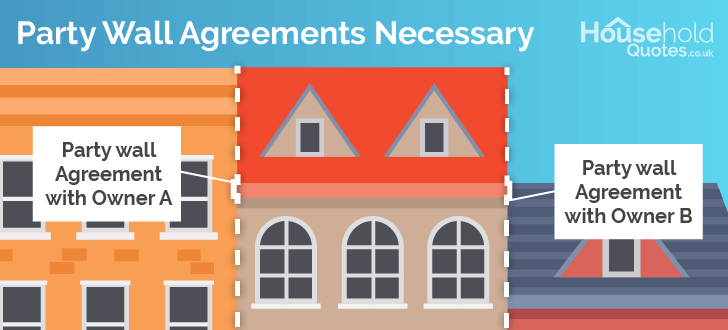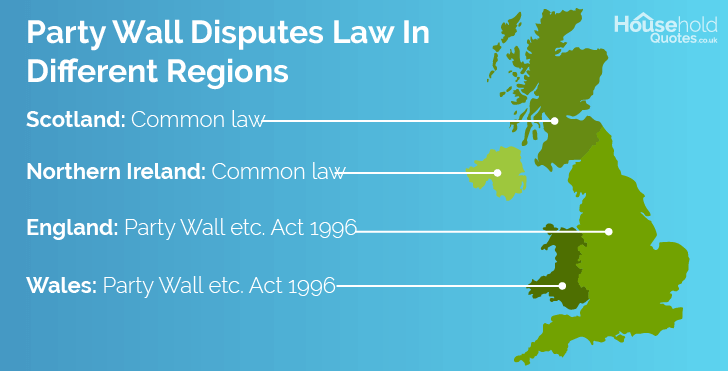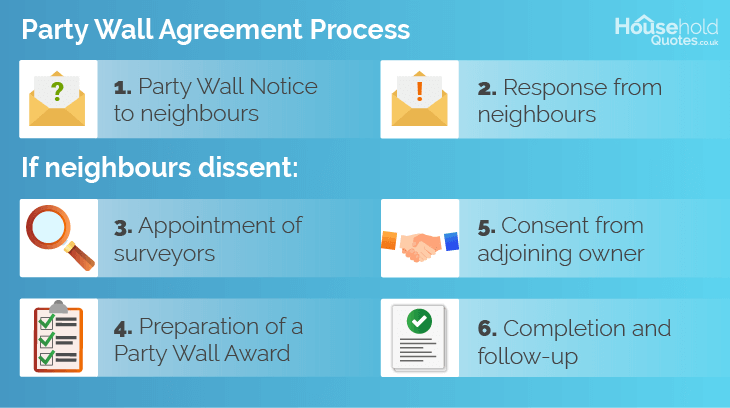
Tell us what you need to find a matching loft conversion specialist

Get free quotes from professionals near you

Compare offers and choose the one that best matches your need
- Householdquotes.co.uk
- Loft Conversion
- Regulations for Loft Conversions
- Party Wall Agreement
Party Wall Agreement For Loft Conversions: Guide


If you're planning a loft conversion, it’s essential to fully understand the requirements of the Party Wall etc. Act 1996. This legislation defines your responsibilities and rights when your home improvements affect a shared wall.
This guide details the crucial steps to obtain a Party Wall Agreement and provides actionable tips to ensure your loft conversion progresses smoothly and without disputes. Whether you are in the early stages of planning or ready to start building, this guide ensures you are well-informed to proceed with confidence.
Complete our quick 30-second form to receive up to three free, no-obligation quotes from our network of trusted local installers, customised to your specific home improvement needs. Click below to get started!
- Describe your needs
- Get free quotes
- Choose the best offer
It only takes 30 seconds



Do you need a Party Wall Agreement for a loft conversion?
Yes, if your property includes a wall that adjoins a neighbouring structure, securing a Party Wall Agreement is essential. Governed by the Party Wall etc. Act 1996, this agreement is legally required before commencing any construction work on your loft that impacts a shared wall.
For mid-terraced homes, this typically means obtaining agreements from both sides of the property, as both adjoining walls are often affected. The law ensures that all parties are protected and informed, mitigating any potential disputes arising from structural changes.
A Party Wall Agreement is typically necessary for semi-detached houses where the loft conversion involves work on a semi-detached party wall or a terrace house loft conversion, with walls shared with neighbouring properties.
Conversely, detached homes usually do not require such agreements for attic conversions in the UK unless they are part of a grouped structure with shared walls.

For loft conversions, several specific types of work on a party wall might necessitate a Party Wall Agreement, including:
- Demolition and rebuilding: If part of the shared wall needs to be demolished and rebuilt to facilitate the loft conversion.
- Cutting into a wall: To insert beams or insertions as part of the loft structure.
- Increasing wall height or thickness: If the conversion plan involves extending or altering the height or thickness of the existing party wall.
- Underpinning a wall: This involves deepening the foundation of a party wall to support additional structural loads from the new loft.
This is especially important for dormer loft conversions, which often involve significant alterations to the roof and may affect the structural integrity of shared walls.

Can a neighbour refuse a loft conversion?
Yes, neighbours can legally refuse a loft conversion if they believe the proposed changes may negatively impact their property. This right is protected under the Party Wall etc. Act 1996, which provides a framework for preventing and resolving disputes regarding party walls, boundary walls, and excavations near neighbouring buildings.
Other loft conversion neighbours' rights which the Party Wall Act 1996 includes:
- Right to a Party Wall Notice: Neighbours must be given notice about any loft conversion plans that affect a shared party wall or boundary. This notice should be served at least two months before the work begins.
- Right to dispute: If neighbours have concerns about the proposed loft conversion's impact on their property, they can formally dispute the plans. This triggers a dispute resolution process, which may involve party wall surveyors.
- Right to protection from damage: If the loft conversion damages a neighbour's property, the homeowner undertaking the conversion is responsible for the repairs.
Engage your neighbours early in the process. A face-to-face conversation about your plans can help prevent misunderstandings and disputes that might otherwise lead to expensive legal proceedings.
What happens if you don't have a Party Wall Agreement?
Neglecting to secure a Party Wall Agreement before starting a loft conversion can lead to significant legal and financial consequences. Under the Party Wall etc. Act 1996, this agreement is a legal requirement when the work involves a shared wall with a neighbouring property.
Here’s what could unfold if this crucial step is overlooked:
Legal consequences
Without a Party Wall Agreement, neighbours have the right to take legal action against those undertaking unauthorised work. This can result in court orders requiring the cessation of all construction activities until proper legal processes are followed.
Courts can also mandate that any changes made to shared property structures be modified, reverted, or reinforced to safeguard the adjoining property’s integrity and safety.
Costly repairs and modifications
Loft conversion costs may rise significantly if your loft conversion damages a neighbouring property or undermines the structural integrity of a shared wall.
Homeowners could be responsible for all repair work required on the neighbouring property, which might involve structural reinforcements or complete rebuilds of damaged sections.
Engaging party wall surveyors and legal assistance to resolve disputes is expensive. Surveyors often charge between £150 and £350 per hour, and legal fees can potentially be thousands of pounds.
Can you do a loft conversion without touching a party wall?
While it may seem feasible to undertake a loft conversion without impacting a party wall, the reality is more complex, and the necessity for a Party Wall Agreement often still applies.
Here's a detailed look at when and how you can proceed with such conversions:
Velux сonversions
Often, Velux conversions do not require alterations to the party walls. These conversions involve installing windows into the existing slope of the roof, thus typically not extending beyond the current roofline or impacting shared walls.
Keep in mind that all types of loft conversion, including Velux conversion, might require scaffolding or other temporary structures that could encroach on a neighbour’s property. In this case, you still need a Party Wall Agreement.
Detached houses
If the loft is being built on top of a stand-alone or detached house, there may be no party walls involved. In such cases, a Party Wall Agreement would not be necessary as there are no adjoining neighbours to consider under the Party Wall etc. Act 1996.
Even in scenarios that seem exempt from party wall implications, it is always prudent to consult with a qualified surveyor. Regulations can vary, and local planning requirements or specific structural considerations might still necessitate a formal agreement or at least a courtesy notification to neighbours.
What is the Party Wall Act 1996?
The Party Wall etc. Act 1996 is a crucial piece of legislation in England and Wales designed to mitigate disputes between neighbours who share a boundary. It provides a framework for preventing and resolving disputes regarding party walls, boundary walls, and excavations near neighbouring buildings.
The Party Wall etc. Act 1996 applies only to England and Wales. Scotland and Northern Ireland have their own laws and regulations regarding building works and neighbour relations:
- Scotland: Uses common law to handle boundary and building disputes. The primary mechanism here involves the law of nuisance and the appointment of a surveyor if needed.
- Northern Ireland: Disputes are generally handled through common law, focusing on the rights of property owners and potential torts like nuisance.

How much does a Party Wall Agreement for a loft conversion cost?
For a basic agreement involving one shared wall, costs can range from approximately £900 to £2,700 when a single-party wall surveyor is involved. This is generally the case when the building works are straightforward and unlikely to cause significant disruption or damage.
If the situation requires two party wall surveyors — one representing each property owner — the loft conversion Party Wall Agreement costs can naturally double. This scenario is more common in complex cases where multiple walls are involved or where the proposed works are extensive, bringing the range to about £1,800 to £5,400.
These figures can vary depending on the surveyors’ fees and the specific demands of the project. Larger properties, more shared walls, and greater complexity generally increase costs.
It is important to note that the person initiating the work, not the neighbour, is responsible for covering these costs. This includes all fees associated with drafting and enforcing the agreement, as well as any additional legal or professional fees incurred during the process.
How can you get a Party Wall Agreement
To initiate work that affects a shared structure, you must serve a Party Wall Notice to your neighbours detailing the work and its start date at least two months before commencing.
A Party Wall Notice must include details such as the property address, the nature of the work, the start date, and a clear statement that it is being served under the Party Wall etc. Act 1996. The notice must be served to all adjoining owners at least two months before the start of the work.
Notices can be hand-delivered or sent via registered mail to ensure there is proof of delivery. It is advisable to discuss the notice in person with your neighbours to foster good relations and address any concerns they may have upfront.
To streamline the process, a loft conversion Party Wall Agreement template can be invaluable. These templates can be found through:
- Government websites: The UK government provides resources and templates related to the Party Wall etc. Act 1996. This is a reliable source for legally vetted documents.
- Professional bodies: Organisations such as the Royal Institution of Chartered Surveyors (RICS) offer guidance and template forms for handling party wall matters. These templates are designed to meet all legal criteria and are regularly updated to reflect current laws.
- Legal service providers: Some legal firms and surveying companies offer free templates as part of their client services. However, it is crucial to ensure that these templates comply with the latest legal standards.
What happens after you serve the notice

Once you have served a Party Wall Notice to your neighbours, the process towards securing a Party Wall Agreement follows a structured path:
1. Response time
Adjoining owners have 14 days to provide a written response. They can agree to the work as proposed, disagree, or request further negotiations.
2. Agreement or dispute
If the neighbour consents to the notice, you can proceed with the works under the conditions outlined in the notice.
However, if they dissent or do not respond, this is considered a dispute, and both parties must then appoint a Party Wall Surveyor or agree to use the same surveyor.
3. Appointment of surveyors
Each party appoints a surveyor (or one surveyor is appointed jointly) to draft a Party Wall Award. This award is a legally binding document detailing the rights and obligations of both parties, the proposed works, and measures to prevent damage.
Surveyors have busy schedules, and finding one who can accommodate a last-minute request can be difficult. Moreover, surveyors often charge higher rates for urgent services. By arranging these services ahead of time, you can avoid the premium that comes with expedited services.
4. Survey and schedule of condition
The appointed surveyor(s) will conduct a survey of the neighbouring property to record its condition before works begin. This schedule of condition ensures any post-work damage can be accurately attributed to the construction work.
5. Finalising the award
Once the survey is complete, the surveyor(s) finalise the Party Wall Award. This document includes details of the work to be undertaken, working hours, measures to prevent damage, and access provisions for the surveyors.
6. Commencement of work
With the Award finalised and agreed upon, construction can commence. The work must comply with the terms set out in the Award.
Keep in mind that in addition to obtaining a Party Wall Agreement, it is imperative to ensure that all aspects of your loft conversion comply with local building regulations for loft conversions.
7. Completion and any necessary repairs
Upon completion of the works, another inspection may be carried out to ensure no damage has occurred. If damage is detected that relates to the construction, the property owner who initiated the work is responsible for the repairs, as stipulated in the Party Wall Award.
If you're considering a loft conversion, it's crucial to seek advice from experts in the field to ensure your project is managed effectively. By consulting with various specialists and comparing their quotes, you can significantly improve both the quality and affordability of your conversion.
To receive personalised, competitive service options, simply complete our quick 30-second form. This will connect you with up to three reliable local installers who will offer you free, customised quotes without any additional fees or obligations. Click below to take the first step toward a successful loft conversion!
- Describe your needs
- Get free quotes
- Choose the best offer
It only takes 30 seconds



FAQ
Yes, a Party Wall Agreement is required for a loft conversion if the work involves a wall shared with an adjoining property. Under the Party Wall etc. Act 1996, it’s a legal requirement to prevent disputes and ensure all parties are protected.
Absolutely. A loft conversion must be signed off to confirm it meets local building regulations and safety standards. This approval process typically involves inspections by local authority building control officers or approved inspectors to ensure compliance with the building codes.
The Party Wall Act 1996 is legislation in England and Wales designed to prevent and resolve disputes related to party walls, boundary walls, and excavations near neighbouring buildings. It requires property owners to notify adjoining neighbours before commencing certain types of construction work.
Yes, neighbours can object to the proposed works covered by the Party Wall etc. Act 1996. If they disagree with the works, both parties must appoint a party wall surveyor to resolve the dispute and ensure the works are carried out considerately and legally.
Failing to obtain a Party Wall Agreement can lead to legal disputes and stop your construction. This oversight can result in costly delays, with potential legal and repair costs that can significantly exceed the initial costs of compliance.

Tania is an experienced writer with a keen interest in home improvement projects. Her motivation stems from a desire to help others create comfortable, functional, and aesthetically pleasing living spaces.
